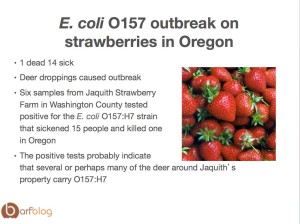Jenina Pellegren of Contagion Live writes that Enterohemorrhagic Escherichia coli (EHEC) are a subset of Shiga toxin–producing E. coli (STEC) that cause diarrhea and hemorrhagic colitis. The illness can progress to hemolytic uremic syndrome (HUS) in 5%-10% of cases.
 In France between 2005 – 2014, a total of 54 patients were infected with EHEC O80:H2; 91% had HUS. Two patients had invasive infections and 2 died. Similar strains were found in Spain with all isolates belonging to the same clonal group.
In France between 2005 – 2014, a total of 54 patients were infected with EHEC O80:H2; 91% had HUS. Two patients had invasive infections and 2 died. Similar strains were found in Spain with all isolates belonging to the same clonal group.
“Azithromycin decreased Shiga toxin in subinhibitory concentrations significantly. Ciproflaxacin increased it substantially and ceftriaxone had no major effect. The occurrence of bacteremia during EHEC infections warranted antibiotic treatment. However, antibiotics are not usually recommended because of the risk for worsening HUS, notably by the secretion of Shiga toxin (Stx). This represents a therapeutic challenge.”
In 2011, an outbreak in Germany linked to EHEC O104:H4 underscored the potential benefit of certain antibiotics when HUS occurs, making the use of antibiotics a source of debate. To determine the incidence rate of HUS cases associated with the singular EHEC O80:H2, a study examined the effects of different antibiotics on Stx production in representative strains.
During January 2005 – October 2014 The Centre National de Reference Associe Escherichia coli, in France, collected 57 different strains of EHEC O80:H2. Isolated from stool specimens of over 54 patients; 2 and 3 isolates each were recovered from 2 patients.
According to the Center for Disease Control and Prevention (CDC) “Among the 53 patients for whom clinical data were available, 49 (91%) had HUS; 27 (51%) were male. Median age for these 48 patients was 1.2 years (range 0.2–39 years, interquartile range [IQR] 0.7–1.6 years). Only 1 adult HUS patient (a 39-year-old) was reported. The 5 (9%) non-HUS patients were largely older (1, 2, 6, 21, and 40 years old). Among HUS patients, fever was present in 45%; median leukocyte count was 13,000 cells/mm3 (data were not available for 14 patients), and 56% had leukocytosis (>11,500 leukocytes/mm3).”
Several studies demonstrated that the effect of antibiotics on HUS depends on their class. Ciprofloxacin raises the production and release of Stx in vitro and is associated with a higher mortality rate in pigs. Yet, other studies indicate azithromycin might decrease the production and release of Stx. However, during a 2011 outbreak of EHEC O104 infection in Germany, a patient treated by ciprofloxacin plus imipenem unexpectedly had a better prognosis.
Despite promising in vitro results, the authors of the study could not advocate the use of these antibiotics for treatment of patients infected with EHEC O80:H2. While potentially promising, these findings are preliminary and require confirmation.





.jpg) American consumers at many supermarket chains unprecedented levels of specificity when it comes to choosing meat to match their principles.
American consumers at many supermarket chains unprecedented levels of specificity when it comes to choosing meat to match their principles..jpg) lived year-round on pasture covered with at least 75 percent vegetation and had legs that were healthy enough to support it by the time it reached market weight.
lived year-round on pasture covered with at least 75 percent vegetation and had legs that were healthy enough to support it by the time it reached market weight. .jpg) One
One .jpg)